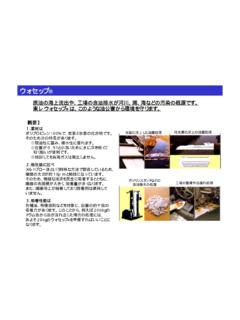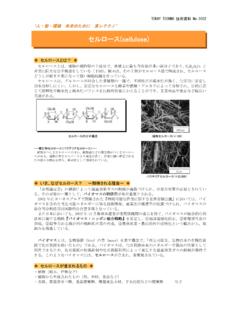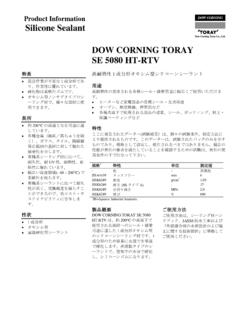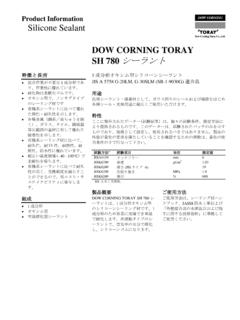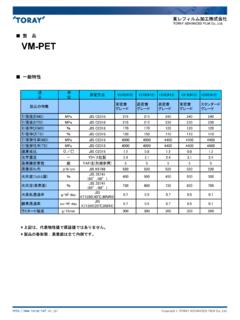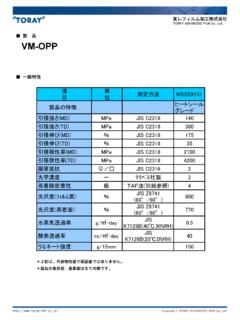Transcription of torayfinechemicals.com THIOKOL LP
1 THIOKOL LP.. (Liquid Polysulfide Polymer). June. 2004. Liquid Polymer Sealants based on polysulfide liquid polymer (LP) have found worldwide acceptance, in industries such as construction, aircraft, insulating glass, automotive, and marine. Construction With the advent of the curtain wall and high-rise structures came need for a sealant which would adhere tenaciously to almost any surface, maintain a weatherproof seal against leakage and have excellent movement capabilities. Aircraft Since the 1940s, sealants based on polysulfide polymers have been used on virtually every commercial and military aircraft. Because of their excellent resistance to fuels, these compounds have been specified for sealing integral fuel-tanks and numerous other areas on aircraft of all sizes.
2 Insulation Glass Only a few compounds can meet the rigid requirements placed on insulation glass sealants. Polysulfide base sealants, because of their excellent adhesion and high resistance to UV, are used in the manufacture of insulating glass units and in glazing applications, specifically windows, patio doors, and windows for environmental chambers. Additional Applications There are many other traditional polysulfide-based applications. Including: Cold molding, potting, formed-in- place gaskets, trailer waterproofing, flexible molds, auto glass and body sealing, filleting and mold sealing, membrane coating, gas main sealing, concrete bonding, plastic tooling, wire and cable sealing, anti-corrosion coating, leather impregnation, chemical resistant coatings, printing rollers, propellant binders, vibration damping and dental molding compounds.
3 Liquid Polymer Applications Application LP-3 LP-33 LP-23 LP-980 LP-2 LP-32 LP-12 LP-31 LP-55 LP-56. Aircraft sealant . Automotive sealants . Building sealants . Flow type sealants . Heavy construction sealants . Insulating glass sealants . Marine sealants . Dental molding compounds . Epoxy modifiers . Fluid membranes . Concrete coatings . Intumescent coatings . Electrical potting . Leather impregnation . Propellant binders . Chemical Properties Properties LP-3 LP-33 LP-23 LP- LP-2 LP-32 LP-12 LP-31 LP-55 LP-56. 980. Color / Gardner 13max 12max 14max 12max 14max 12max 12max 12max 12max 12max Viscosity at 25C(77F)/Pa s 12 12 45 45 45 130 45 18. Moisture content / %. Mercaptan content / %. Average molecular weight 1000 1000 2500 2500 4000 4000 4000 7500 4000 3000.
4 Refractive index n/D - - - - Flash point(PMCC) / C(F) >177 >177 >177 >177 >177 >177 >177 >177 >177 >177. (350) (350) (350) (350) (350) (350) (350) (350) (350) (350). Cross-linking agent / % Specific gravity at 25C(77F) Chemical Structure and Curing Mechanism (LPs). Chemical Structure Polysulfides are polymers of bis-(ethylene oxy) methane containing disulfide linkages. The reactive terminal groups used for curing are mercaptans (-SH). The general structure is: HS(C2H4-O-CH2-O-C2H4SS)xC2H4-O-CH2-O-C2H 4SH. Curing Mechanism for LP Polysulfide Polymers Curing of liquid polysulfide polymers to high molecular weight elastomers is normally accomplished by oxidizing the polymer's thiol (-SH) terminals to disulfide (-S-S-) bonds. 2 R-SH + (O) -R-S-S-R- + H2O.
5 The curing agents most commonly used are oxygen donating materials such as manganese dioxide, calcium peroxide, cumene hydroperoxide, and p-quinone dioxime. Lower valence metallic oxides, other organic hydroperoxides, metallic paint driers, and aldehydes can also function as curatives. Selection of Curing Agents (LP-2,12,31,32). The final selection of a curing agent is based on its overall perfomance with respect to a number of requirements, including: cost, stability, controllable cure rate, heat stability of cured composition, elastomeric properties, toxicity, etc. With LP-2, LP-12, LP-31, LP-32. (Note that LP-31, because of its higher molecular weight, requires generally less curative than is recommended in the following paragraphs.). **MnO2(active grade)**.
6 Provides polysulfide polymer based compositions with improved heat resistance. Amount required per 100 parts of polysufide polymer: parts. **CaO2**. Requires moisture for activation. It can be used to provide a white one-part moisture curing system. Amount required per 100 parts of polysufide polymer: parts. **ZnO2**. Reacts slowly with LP polymers. It can be used to provide white compositions with moderate heat stability. Amount required per 100 parts of polysufide polymer: parts. **Cumene Hydroperoxide**. It is in convenient liquid form which is useful for obtaining pourable compositions that have compression set resistance. Amount required per 100 parts of polysufide polymer: parts. Selection of Curing Agents (LP-3,33). With LP-3, LP-33.
7 **MnO2(active grade)**. Permits room temperature cures sith the addition of to 4 parts of m-dinitrobenzene as an accelerator. Amount of MnO2 required per 100 parts of polysufide polymer: 2-6 parts. **Para-Quinonedioxime(GMF)**. Requires heat activation and the addition of parts of diphenyl-guanidine(DPG). Amount of GMF required per 100 parts of polysufide polymer: 5-7 parts. **Others**. LP-3 and LP-33 can slso co-cure with various polymers to yield elastomeric and/or plastic properties based on the ratio of ingredients used. In particular, epoxy resins in conjunction with aliphatic or aromatic amines are commonly co-cured with the polysulfides, The following cure mechanism is suggested: -C-C- + HS-R-SH + -C-C- -C-C-S-R-S-C-C- O O OH OH. Compounding Compounding and Processing Liquid polymers are compounded with a variety of plasticizers, reinforcing agents, thixotropes, and extending fillers which influence the composition's dynamic properties, viscosity, and cost.
8 Processing of most liquid polymer compositions requires the use of high shear mixing equipment. Most widely used are sigma blade and planetary type mixers, high speed dispersers and three-roll paint mills. Adhesion Properties Excellent adhesions to most substrates, coupled with good flexibility, is obtained with properly compounded polysulfide polymer based compositions. Typical values obtained are peel adhesions of approximately to kg/cm (20 to 60 lb/in) to aluminium, glass, and steel surfaces. Shear values to aluminium range from approximately 7 to 14 kg/cm2 (100 to 200 lb/in2) for cross-sections (1/8 inch). thick. Electrical Properties Electrical Properties Cured liquid polysulfide polymers have good electrical properties which can be improved through compounding.
9 Typical electrical and special properties at 25C (77F) and 50% relative humidity of cured compositions are shown in Table. Electrical Properties Volume resistivity (ohm-cm) 1x1011 7x1012. Surface resistivity (ohm) 1x1012 2x1014. Dielectric constant @ 1Kc 8. Dissipation factor @ 1Kc Resistance Oil, Solvent, and Chemical Resistance Cured liquid polysulfide based compositions display excellent resistance to a wide number of oils and solvents including aliphatic and aromatic hydrocarbons, seters, ketones, dilute acids and alkalies. Table shows typical volume swell values on specimens immersed in solvent for 30 days at 27C (80F). Solvent and Oil Volume Swell(%). ASTM Reference Fuel A -1 to -7. ASTM Reference Fuel B 1 to 12. ASTM Oil -7 to 5. JP-5 -5 to 12.
10 Aging and Weather Resistance Cured Liquid polysulide polymer based compositions display excellent resistance to aging, ozone, oxidation, sunlight, and weathering. Long term Weather-ometer tests, as well as actual usage, indicate that these materials have excellent resistance to daily exposure in varying climates. Toxicological Properties Toxicological Properties of LP Polysulfide Polymers Liquid polysulfide polymers are relatively non-toxic. The actual oral toxicity of LP-3 has been measured in rats as g/kg body weight (equivalent to table salt), and other LP polymers were measured as being even less toxic orally. Eye irratation test conducted on rabbits showed no corneal or iridial effects, but slight conjunctival involvement was found for LP-32 and LP-33.


